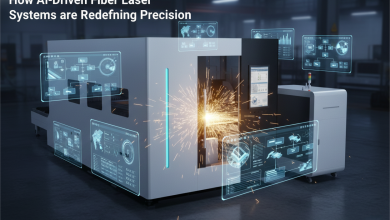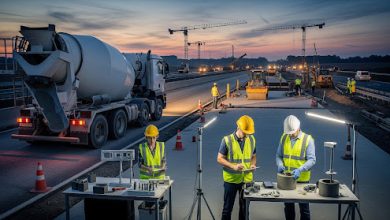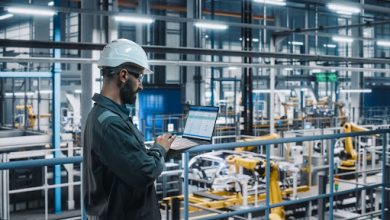Does the construction industry have a delay problem? According to recent studies, labor productivity in the sector has continued to decline at an average yearly rate of 1%. While these statistics are low, constant scheduling errors and cost overruns are costing the US $40 billion in losses annually.
Just 8.5% of large-scale projects are completed on time in 2025, posing a giant issue for the sector as a whole, especially as labor forces continue to dwindle.
The construction sector is set for an industry-wide revamp. While construction businesses have historically been slow to adopt new digital technologies, the introduction of AI in the industry aims to transform the industry.
The question is, could AI solve construction’s chronic scheduling issues? With the ability to prevent schedule overruns, forecast budgets, and bridge labor gaps, AI could force industry leaders to ditch legacy tech and jump headfirst into an automated future.
Why Traditional Scheduling Fails
Before we jump into the numerous ways AI is redefining project scheduling, let’s take a closer look at some of the common failures pushing construction teams to make a change.
- Poor Communication: Delayed or fragmented communication can lead to numerous errors on the project. For teams working across multiple platforms, a lack of a centralized system can quickly misalign responsibilities, leaving the team vulnerable to mistakes and scheduling delays.
- Incomplete Field Data: If systems are not updated automatically, they rely on field teams to input their actions manually. This often means that a manager may not be aware of actual worker activity until days later.
- Estimated Resource Allocation: If real-time data does not power your inventory, your team must rely on static assumptions when it comes to resource allocation. This can lead to over-ordering parts, cost overruns, and project delays if your inventory is understocked.
From poor communication to uninformed resource allocation, manual project management is a significant contributor to the fact that large construction projects typically run 80% over budget and 20 months behind schedule, resulting in billions of dollars in lost productivity annually.
Moving Beyond Legacy Systems with AI
It’s time to move beyond legacy systems when it comes to project scheduling. The current cycle of delays is a direct result of the limitations of legacy tools.
As construction businesses move away from document-centric management to data-driven automation, they are much more likely to hit deadlines on time and stick to their budget.
AI-powered scheduling frameworks serve as an intelligent, centralized hub accessible to all parties involved in a project. They are designed not only to gather and store information but also to process historical project data to forecast future resource allocation, deadlines, and an accurate budget for the team moving forward.
In fact, 92% of construction companies are already making the switch to AI in 2025.
With this in mind, let’s take a closer look at how AI could solve the sector’s delay problem in the snap of a finger.
Three Ways AI Is Solving Construction’s Chronic Delay Problem
From minimizing project delays to streamlining the supply chain, AI’s ability to transform project planning and execution has become a game-changer for overwhelmed construction teams.
Here are just a few ways AI can minimize construction delays:
Intelligent Scheduling
It’s no secret that construction delays can result in cost overruns and lost opportunities. Investing in an AI-powered end-to-end construction management software like Access Construction is the key to simplifying your project scheduling.
Intelligent scheduling systems help project managers automate project run times, forecast potential delays, and stay on top of material shipments and warehouse stock levels.
Better still, most CMS systems come with an integrated dashboard offering a centralized view of every aspect of the project timeline. All team members and stakeholders, as well as the client, can access this information, ensuring that each party involved remains informed and can react swiftly to potential errors.
Streamlining The Supply Chain
As a construction firm, you’ll manage vast, complex supply chains for each project you take on.
AI ensures that your supply chain runs smoothly by analyzing data on quality control, supplier performance, and historical resource allocation. This makes it much easier to identify bottlenecks early in the project and react swiftly for a timely completion.
Better still, if you are facing delivery delays and shortages, some AI-powered CMS systems may suggest alternative suppliers and resources based on historical collaborations and other network connections in your working area.
Mitigating Labor Shortages
Did you know that one in four construction workers in the US is over 55? With a rapidly ageing labor force, the construction industry lost an estimated 9 million workers in 2024, with many retiring from the sector altogether.
To avoid delays caused by labor shortages, you can now use AI platforms like Co-Pilot to take on tedious tasks, automate data input, and answer worker queries 24/7.
When it comes to onboarding new hires, AI also makes the process easier, offering new hires step-by-step training instructions, machinery tutorials, and on-the-job support if a team member is unable to mentor them at all times.
This boosts productivity and helps you create a team that is confident in leaning on tech during the learning process. If all workers are free to attend to their role during the project, delays become less common and deadlines are met much quicker.
Wrapping Up
For some projects, delays are inevitable in the construction sector. However, with the introduction of AI in the industry, significant deadline delays are becoming less common.
AI can support your team as if it were another working member. From automated data input to predictive analytics, those who invest in AI stay ahead of their schedule, on top of their supplier interactions, and in the loop with all employees.
The era of legacy construction software is over. Those who fail to make the switch will continue to fall behind in an ever-growing digitalized construction sector.




